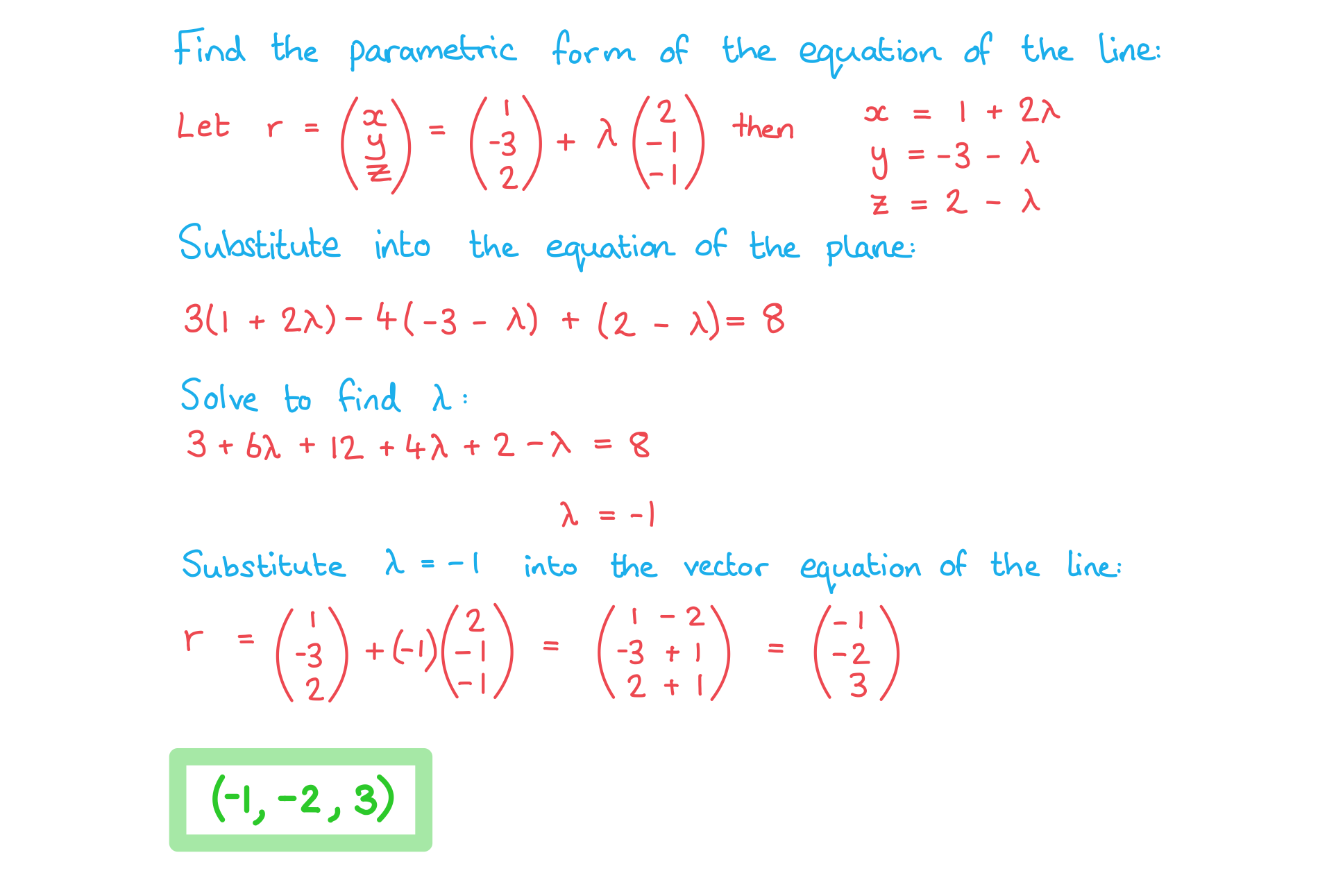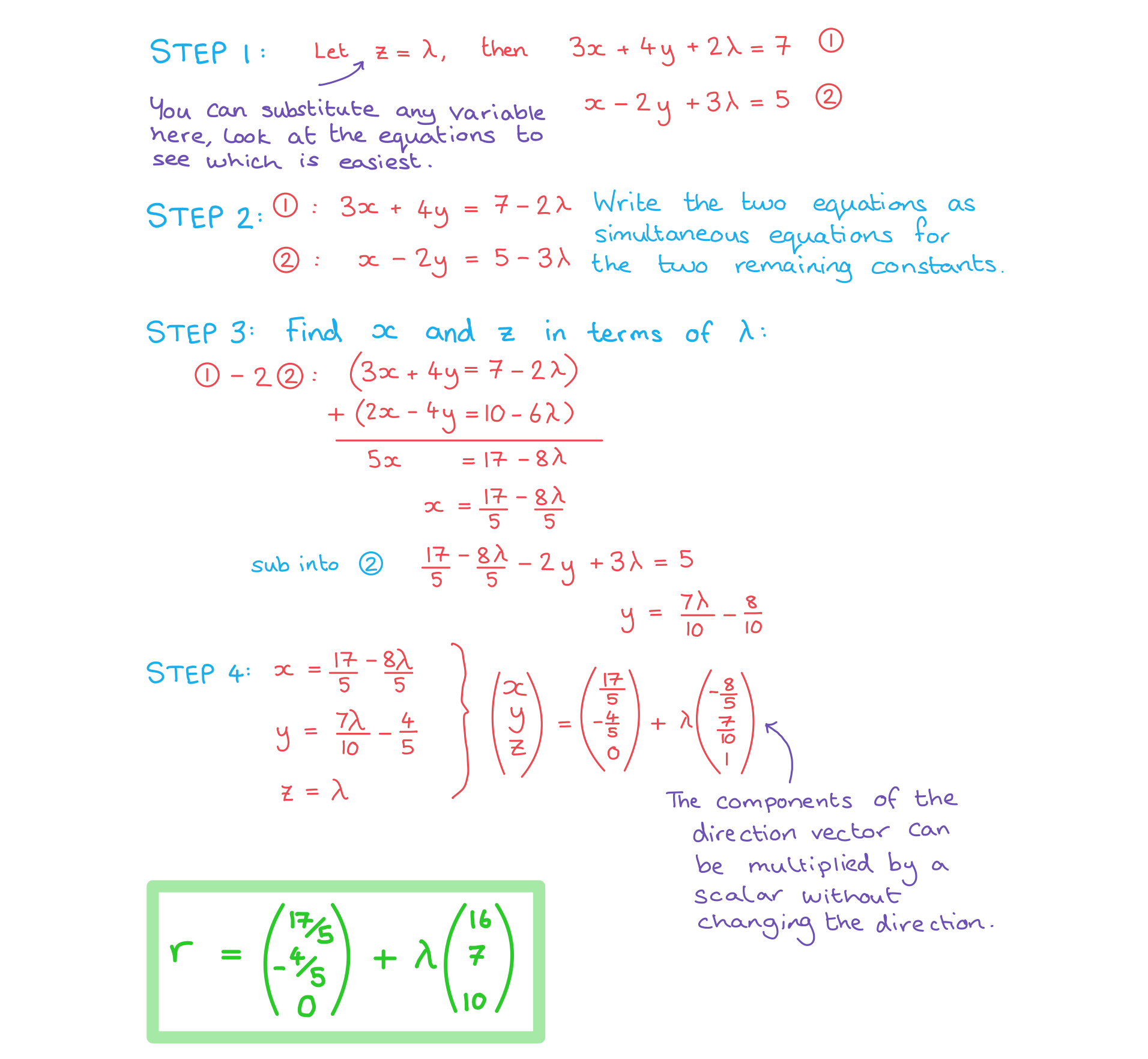Intersection of Line & Plane
How do I tell if a line is parallel to a plane?
- A line is parallel to a plane if its direction vector is perpendicular to the plane’s normal vector
- If you know the Cartesian equation of the plane in the form
then the values of a, b, and c are the individual components of a normal vector to the plane
- The scalar product can be used to check in the direction vector and the normal vector are perpendicular
- If two vectors are perpendicular their scalar product will be zero
How do I tell if the line lies inside the plane?
- If the line is parallel to the plane then it will either never intersect or it will lie inside the plane
- Check to see if they have a common point
- If a line is parallel to a plane and they share any point, then the line lies inside the plane
How do I find the point of intersection of a line and a plane?
- If a line is not parallel to a plane it will intersect it at a single point
- If both the vector equation of the line and the Cartesian equation of the plane is known then this can be found by:
- STEP 1: Set the position vector of the point you are looking for to have the individual components x, y, and z and substitute into the vector equation of the line
- STEP 2: Find the parametric equations in terms of x, y, and z
- STEP 3: Substitute these parametric equations into the Cartesian equation of the plane and solve to find λ
- STEP 4: Substitute this value of λ back into the vector equation of the line and use it to find the position vector of the point of intersection
- STEP 5: Check this value in the Cartesian equation of the plane to make sure you have the correct answer
Worked Example
Find the point of intersection of the line with the plane

Intersection of Planes
How do we find the line of intersection of two planes?
- Two planes will either be parallel or they will intersect along a line
- Consider the point where a wall meets a floor or a ceiling
- You will need to find the equation of the line of intersection
- If you have the Cartesian forms of the two planes then the equation of the line of intersection can be found by solving the two equations simultaneously
- As the solution is a vector equation of a line rather than a unique point you will see below how the equation of the line can be found by part solving the equations
- For example:
(1)
(2)
- STEP 1: Choose one variable and substitute this variable for λ in both equations
- For example, letting x = λ gives:
(1)
(2)
- For example, letting x = λ gives:
- STEP 2: Rearrange the two equations to bring λ to one side
- Equations (1) and (2) become
-
(1)
(2)
-
- Equations (1) and (2) become
- STEP 3: Solve the equations simultaneously to find the two variables in terms of λ
- 3(1) – (2) Gives
- Substituting this into (1) gives
- 3(1) – (2) Gives
- STEP 4: Write the three parametric equations for x, y, and z in terms of λ and convert into the vector equation of a line in the form
- The parametric equations
- Become
- The parametric equations
- If you have fractions in your direction vector you can change its magnitude by multiplying each one by their common denominator
- The magnitude of the direction vector can be changed without changing the equation of a line
- An alternative method is to find two points on both planes by setting either x, y, or z to zero and solving the system of equations using your GDC or row reduction
- Repeat this twice to get two points on both planes
- These two points can then be used to find the vector equation of the line between them
- This will be the line of intersection of the planes
- This method relies on the line of intersection having points where the chosen variables are equal to zero
How do we find the relationship between three planes?
- Three planes could either be parallel, intersect at one point, or intersect along a line
- If the three planes have a unique point of intersection this point can be found by using your GDC (or row reduction) to solve the three equations in their Cartesian form
- Make sure you know how to use your GDC to solve a system of linear equations
- Enter all three equations in for the three variables x, y, and z
- Your GDC will give you the unique solution which will be the coordinates of the point of intersection
- If the three planes do not intersect at a unique point you will not be able to use your GDC to solve the equations
- If there are no solutions to the system of Cartesian equations then there is no unique point of intersection
- If the three planes are all parallel their normal vectors will be parallel to each other
- Show that the normal vectors all have equivalent direction vectors
- These direction vectors may be scalar multiples of each other
- If the three planes have no point of intersection and are not all parallel they may have a relationship such as:
- Each plane intersects two other planes such that they form a prism (none are parallel)
- Two planes are parallel with the third plane intersecting each of them
- Check the normal vectors to see if any two of the planes are parallel to decide which relationship they have
- If the three planes intersect along a line there will not be a unique solution to the three equations but there will be a vector equation of a line that will satisfy the three equations
- The system of equations will need to be solved by elimination or row reduction
- Choose one variable to substitute for λ
- Solve two of the equations simultaneously to find the other two variables in terms of λ
- Write x, y, and z in terms of λ in the parametric form of the equation of the line and convert into the vector form of the equation of a line

Exam Tip
- In an exam you may need to decide the relationship between three planes by using row reduction to determine the number of solutions
- Make sure you are confident using row reduction to solve systems of linear equations
- Make sure you remember the different forms three planes can take
Worked Example
Two planes and
are defined by the equations:
Find the vector equation of the line of intersection of the two planes.

